Welcome to S4’s Climate Week challenge!
We are asking for your help with a science question all about fiery firebreak leaves!!
How many colours of autumn leaves are there in Wales?
Have you noticed the autumn leaves are amazing this year? But how many colours are there? And what do to the colours tell us about the chemistry of autumn leaves?

Help us to find out how many colours of autumn leaves there are in Wales!
Join in by taking photos of as many different coloured autumn leaves as you can and upload them to our website here.
This will allow us to calculate the colour of leaves across Wales and find out what autumn colour chemicals are most common in Wales this year.
Choose a beautiful autumn leaf from the floor! Pick a leaf that has fallen recently and is not decayed.
The leaf on the left is a good leaf to choose to photograph and the leaf on the right is not a good leaf to choose to photograph, because it has already started rotting.

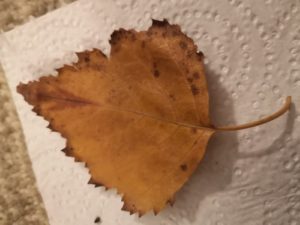
Do not pick any leaves that are still on the trees, only choose leaves that have fallen. If you are able to take a photo of a single leaf which is still on the tree then you can go ahead and do that, but do not climb trees or put yourself in danger. Have an adult with you to help out. Be careful picking leaves up off the floor and wash your hands afterwards. Do not stand under and broken tree branches and avoid collecting your leaves in high winds.
Don’t forget we all still need to follow the current Firebreak rules for Wales, even when we’re outside!
Take a close-up photo, as close as you can for the photo to still be in focus, on a smartphone or camera, with all the filters switched off.
Try to fit the whole leaf in your picture so our scientists can work out what species of tree it came from.
Take a photo of a single leaf, on a simple background (the floor is great!)
Like this:
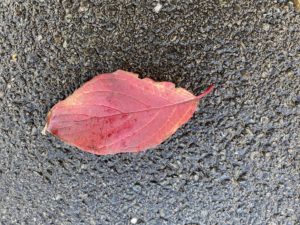
Then place your leaf back on the floor where it can rot down and return its nutrients to the soil! Don’t worry if your leaf was on concrete or pavement, you can just put it back wherever you found it.
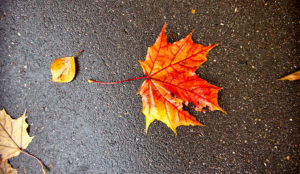
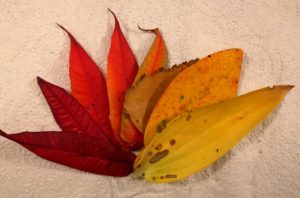 Autumn colour chemistry!
Autumn colour chemistry!
Leaf colour is particularly good this year because we have had a warmer and drier growing season than average.
Spring was sunnier and drier than average, sd was early autumn. The average temperature for the UK was 14.8 °C this summer, which is 0.4 °C above the 1981-2010 average summer temperature. But mean maximum temperatures were up to 1 °C above average in the month of September, and nearly 1.5 °C warmer than average in some parts of the UK. That is a lot warmer than average!
You can read more about our climate this year from the Met office, here.
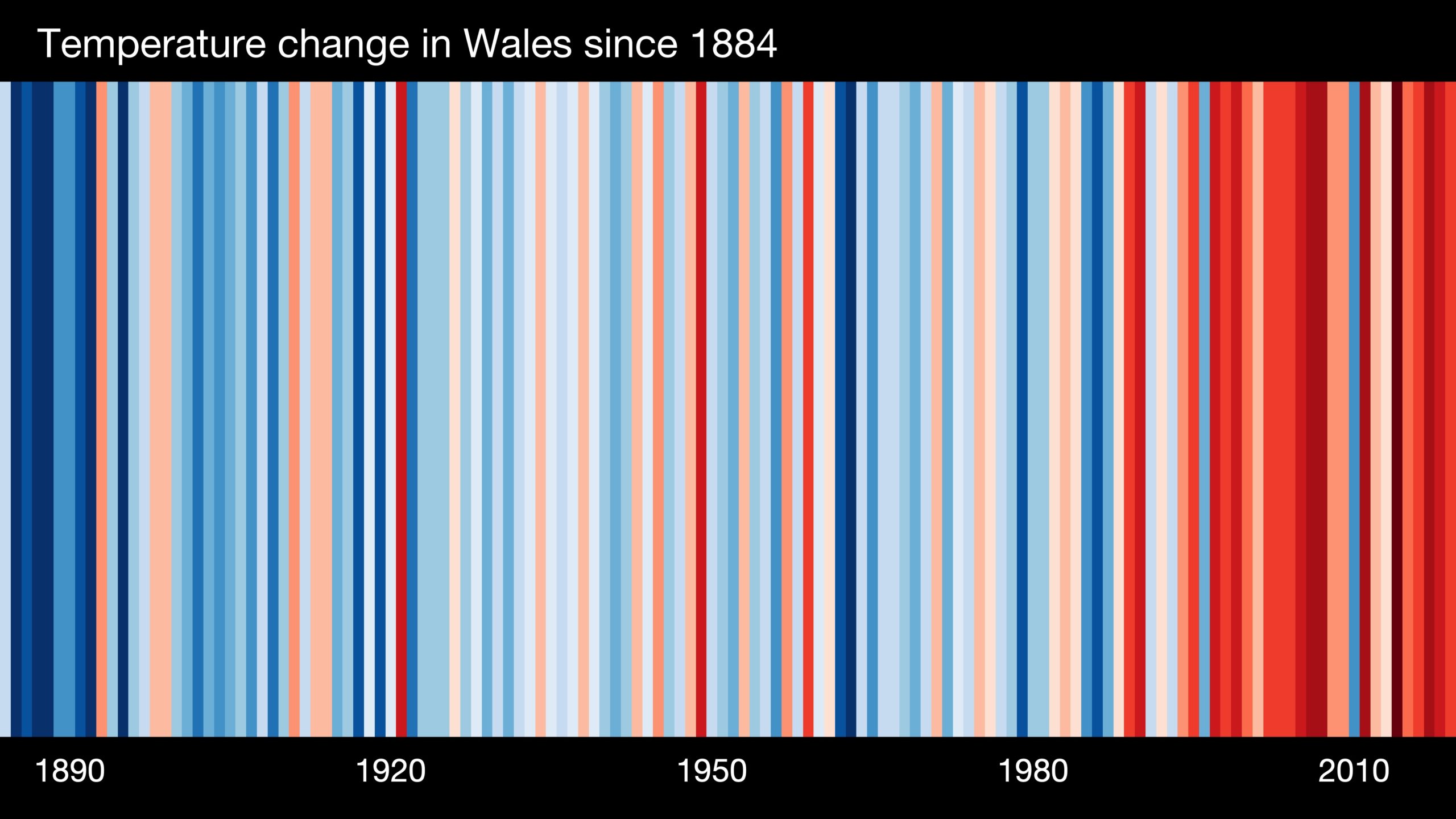
We all know leaves are green in the summer. This is because they are busily producing a green photosynthetic pigment called chlorophyll.
Photo means light and synthesise means to make something so photosynthetic means making something using light.
The chlorophyll molecule has the shape of a big ring of atoms, closed at one end. It is a bit like the shape of the haemoglobin pigment that makes our blood red! This closed ring, in chlorophyll, contains the element magnesium though, not iron.
Plants only produce chlorophyll when it is warm and light. As autumn begins there is less daylight and this tells deciduous trees (trees like oak and beech that lose their leaves in the autumn) that is time to stop making chlorophyll and drop their leaves for the winter. The amount of chlorophyll the tree produces slows down and then stops and the chlorophyll decays away in the leaf.The pigments that make leaves yellow or orange are always there in the leaf it is just that they can only show through when chlorophyll production stops in the autumn and the chlorophyll pigment starts to break down. The red pigments are special and are only made at the end of the growing season, from sugars in the leaf.
Yellow autumn leaves
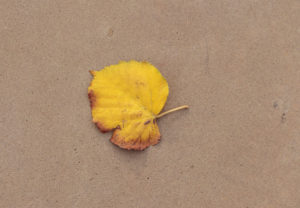
The pigment that makes autumn leaves yellow is a type of carotenoid pigment called xanthophyll.
Carotenoids are very long chain molecules that are made inside plant cells. They are water repellent and give plant leaves and vegetables their yellow and orange colour. Did you see the beautiful sunflowers at Rhosili this summer? Those bright yellow and orange flower petals were coloured by carotenoid pigments, the same as you see now in autumn leaves.
Xanthophyll pigments, in the summer, are there to stop the leaf sustaining sun damage. They dissipate any extra light energy the leaf receives which cant be used for photosynthesis, so that it does not harm the leaf. They are leaf sun lotion!
One of the xanthophyll pigments, called lutein, is also what makes the yolk of eggs yellow! There are lots of molecules that occur in different places in nature, both in the plant and animal kingdoms.
If you found a yellow leaf you have found one with lots of xanthophyll left in it after the green chlorophyll has broken down.
Orange autumn leaves
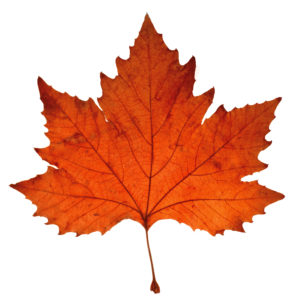
The pigment involved when we find an orange autumn leaf is a type of carotenoid pigment called beta carotene. The name gives you a clue what other plants might contain a lot of beta CAROTene.
Beta carotene is one of the most common carotenoids we find in plant leaves. It actually starts to break down when chlorophyll does in the autumn, but it breaks down more slowly than the chlorophyll, giving leaves their lovely orange colour!
Like most of the other carotenoids, beta carotene is a long, chain molecule.
Red autumn leaves
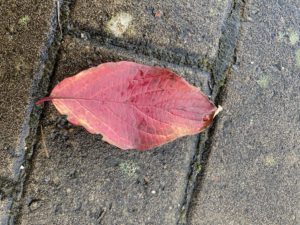
Red autumn leaves contain a different, very special, pigment called anthocynanin. Unlike carotenoids, anthocyanin is water soluble and is produced from sugars that are trapped in the leaf. In fact, anthocyanins pigments have a sugar molecule attached to them, inside the plant cell.
Anthocyanins are also responsible for giving a red colour to some apples and to most red flowers.
We hope you’ve enjoyed reading about autumn leaves and don’t forget to upload those autumn leaf photos here!
Help us to work out what colour Wales is in the autumn!